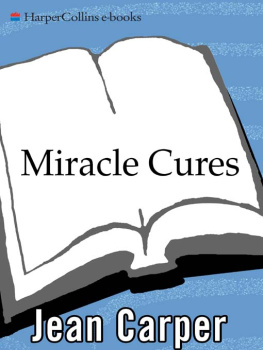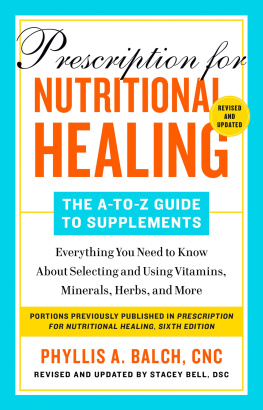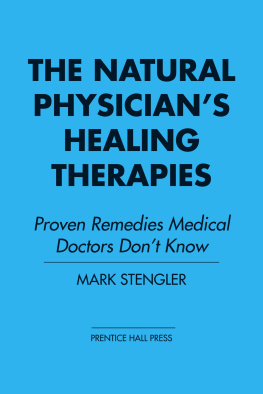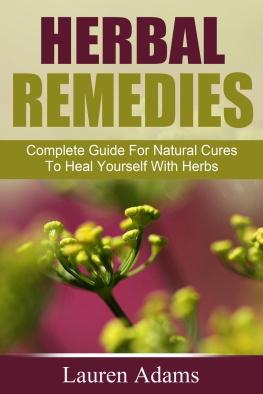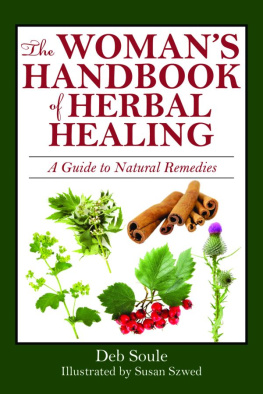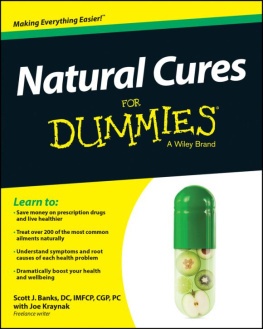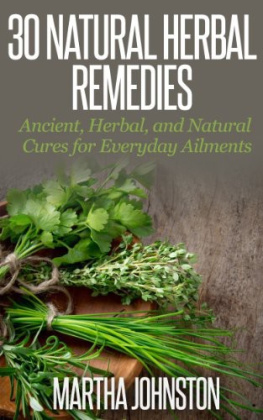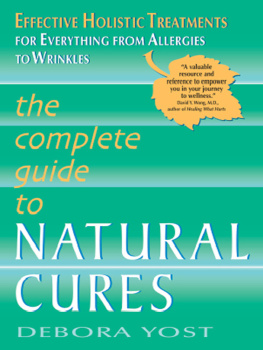To all the Carpers
As always, I would like to thank the many scientists, researchers, doctors, and other health professionals who shared with me their research and expertise, making this book possible. In particular, Mark Blumenthal, executive director, American Botanical Council; Dr. Donald Brown, director of Natural Products Research Consultants; Luke Bucci, Ph.D., expert on natural products; Jerry Cott, Ph.D., National Institute of Mental Health; James Duke, Ph.D., formerly with the U.S. Department of Agriculture and the author of many books on medicinal plants; Norman Farnsworth, Ph.D., University of Illinois at Chicago; Balz Frei, Ph.D., Boston University; Turan Itil, M.D., clinical professor of psychiatry, New York University; Tricia LeFebvre, Primary Services International; Rob McCaleb, the Herb Research Institute; Dr. Michael Murray, author and national authority on natural remedies; Richard Passwater, Ph.D., author of many books on natural remedies; Norman Rosenthal, M.D., National Institute of Mental Health; Norman Salem, Ph.D., National Institute of Mental Health; Stephen Sinatra, M.D., assistant clinical professor, University of Connecticut; Daniel Tucker, M.D., Good Samaritan Medical Center, West Palm Beach, Florida; Varro Tyler, Ph.D., professor emeritus of pharmacognosy, Purdue University; Marcia Zimmerman, a California consultant, who was a primary source on OPCs.
I would especially like to double-thank Mark Blumenthal for his expert comments in reviewing sections of the book dealing with botanical medicines before publication. Also, I owe a special debt to Varro Tyler, Ph.D., a distinguished authority on botanical medicines, who patiently and expertly answered all my questions and sat for numerous interviews that contributed greatly to this book.
Dozens of people added to the vitality and importance of this book by sharing personal experiences of their miracle cures. They are mentioned throughout the book, sometimes by actual name, and sometimes by a pseudonym at their request, to protect their privacy.
This book could not have been written without the enormous contribution of two researchers who tracked down patients, doctors, and research studies: Brenda Turner and Peggy Noonan. Special thanks to Brenda for devoting her full four-month sabbatical from her job as an editor at USA Weekend to making this book happen.
As always, thanks to both my publisher, Gladys Justin Carr, and my agent, Raphael Sagalyn, for seeing the potential of this book and making its realization possible.
It is hard to imagine writing a book without the expert editorial input of my longtime friend, television producer Thea Flaum, who knows how much I treasure and respect her advice.
This book will educate the reader about natural drugs, remedies, treatments, medicines, cures, and dietary supplements. It is based on the personal experiences, research, and observations of the author, who is not a medical or naturopathic doctor. This book is intended to be informational and by no means should be considered a substitute for advice from a medical or health professional, who should be consulted by the reader in matters relating to his or her health and particularly in respect to any symptoms that may require medical attention. While every effort has been made to ensure that drug selections and dosages are in accordance with current recommendations and practices, because of ongoing research and other factors, the reader is cautioned to check with a health professional about specific recommendations. Anyone with a known disease or serious health condition or who is taking prescription medications should especially seek professional medical advice before taking the natural remedies described in this book. There could be interactions between the natural remedies and other drugs. Also it should be noted that all dosages discussed in this book apply to adults, not children, unless otherwise stated. The author and publisher expressly disclaim responsibility for any adverse effects arising from the use or application of the information contained in this book.
I went not only to the doctors, but also to barbers, bath-keepers, learned physicians, women, and magicians who pursue the art of healing; I went to alchemists, monasteries, to nobles and the common folk, to the experts and the simple.
P ARACELSUS (14431541)
T his book is a personal investigation into the validity of natural drugs, remedies, treatments, medicines, and cures, and their accelerating integration into mainstream medicine. While writing and researching the book, I was constantly surprised and impressed by the vigor of this national trend. The incorporation of natural medicinals into conventional medicine is happening much faster than most people realize. And it will eventually have a dramatic beneficial impact, if it has not already, on all of us personally and on the quality and cost of our health care. We are talking about major changes and reforms in a basic structure of all medical systems, from ancient to modern: the appropriate use of drugs to overcome sickness.
Heres what surprised me most:
- The intensity and persistence of people in seeking safer, effective cures outside conventional treatments, even in the face of resistance from establishment medicine.
- The willingness, even eagerness, of leading doctors and scientists at the very core of modern scientific medicineat the National Institutes of Health and prestigious research and academic centersto explore the potential of unconventional remedies.
- The mounting scientific evidence supporting the validity and safety of natural remedies.
- The extensive study and use of such natural remedies among mainstream doctors in other countries, especially Germany.
- The utter chaos of government regulations regarding the use of natural medicines, which is reflected in a consumer nightmare in the marketplace.
When I started this book, I knew, of course, that Americans are embarked on a new direction in seeking solutions for their own health problems. But I had no idea of the strength and pervasiveness of this quest at all strata of society. It was inspiring to talk to people from all walks of life who had developed their own personal health agendas, expending enormous energy to find alternative treatments when they felt mainstream medicine had failed them by providing ineffective treatments or treatments that carried more risk than they wanted to take. Dozens of people openly expressed sentiments ranging from discouragement and resentment to enthusiasm and hope about their personal predicaments. I collected case histories and personal stories from truck drivers, boat captains, airline pilots, doctors, lawyers, secretaries, librarians, journalists, factory workers, computer operators, biochemists, psychologists, teachers, athletes, pharmacologists, botanists, and legislators. Each one had a story of how he or she had suffered and been helped by what is called alternative or complementary medicinesomething not typically offered by conventional medicine.
Their exuberance over their successes affirmed the title of this book. Virtually all of them used the term miracle cure in recounting their experiences. Even doctors, I found, often used the word miracle in describing what happened when a patient suddenly got well after taking a natural remedy. The word miracle is defined in dictionaries as a wonder, a marvel, as well as an act or happening that departs from the laws of nature. Thus, when a person recovers after taking a natural substance, the event is so incongruous with conventional medical expectations that the first words of surprise and overwhelming gratitude are typically: Its a miracle cure. We often say the same thing about conventional treatments that amaze us.

